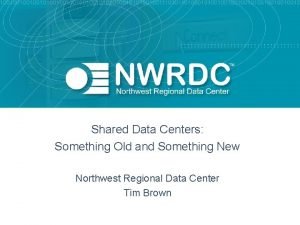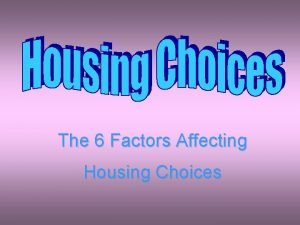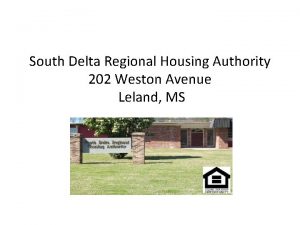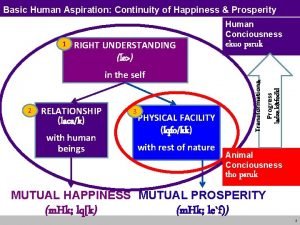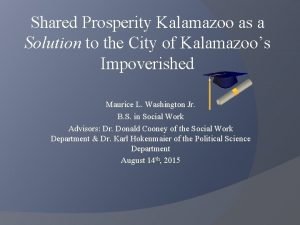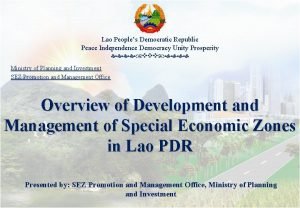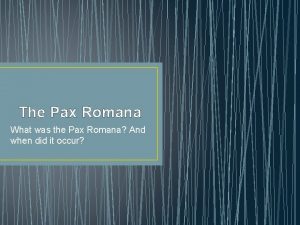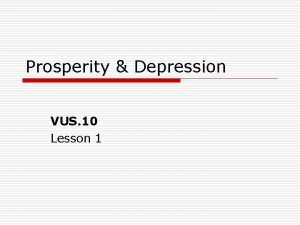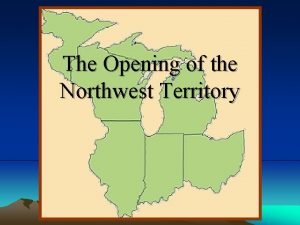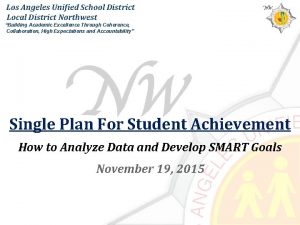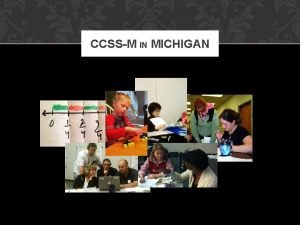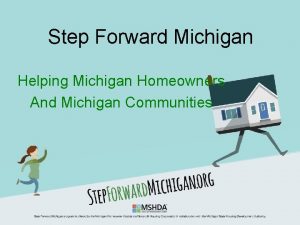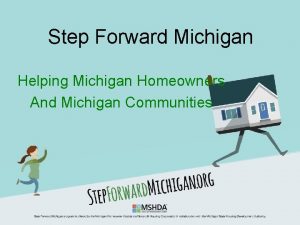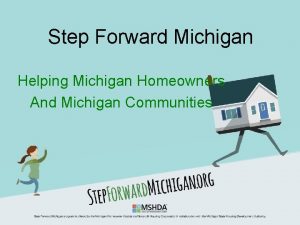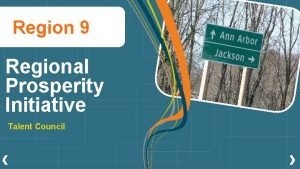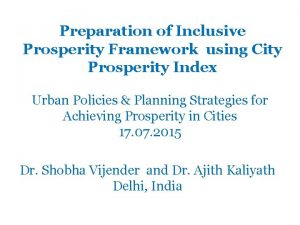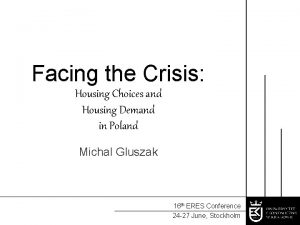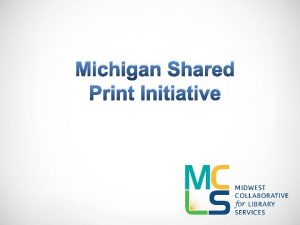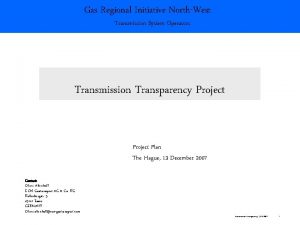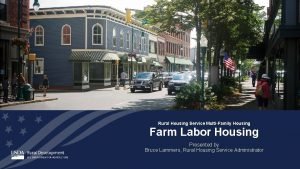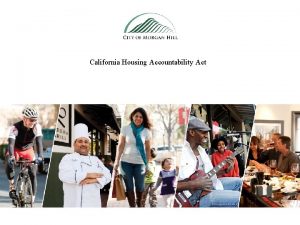Northwest Michigan Regional Prosperity Initiative Creating Housing Choices


































- Slides: 34

Northwest Michigan Regional Prosperity Initiative Creating Housing Choices in Leelanau County

Population Change by Age, 20002010 % Change in Population by Age Cohort, 2000 -2010 51% 49% 48% 29% 17% 22% 5% -2% -9% -2% -13% -7% U 5 - nd er 5 ye ar s 9 10 yea -1 rs 4 ye ar s 15 -1 9 20 -2 4 25 -3 4 35 -4 4 45 -5 4 55 -5 9 60 -6 4 65 -7 4 85 75 an -84 d ol de r -23%

As population ages, #s of families and households with children decline Northwest Michigan -9% -3% Wexford -11% Missuakee -15% Manistee -16% Leelanau -10% Kalkaska Grand -3%Traverse -6% Emmet -14% Charlevoix -5% -12% Benzie Antrim

Housing Needs �Affordable housing �Safe, adequate, quality homes �Homes for small households & seniors �Rentals �Location-efficient homes �Combined housing + transportation costs = 57% + of a typical household’s income �Energy-efficient homes �Propane costs 3 -4 times higher than costs of

Target Market Analyses � Studies the potential market demand from households “on the move” for multi-family units �Attached homes = townhomes, apartments, lofts, etc. �Households = those that live in the County now, as well as those that might move to attached housing in urban settings if there were the right mix of housing options � Young professionals, low income households, young families, retirees, high-income empty nesters/retirees




Barriers: Policy �Zoning affects the cost and availability of land, can discourage – or encourage: �Diverse housing choices �Affordable housing �Location-efficient housing �Sometimes creates uncertainty or delays for developers – time is money

Barrier: Public Perception �Stereotypes about affordable housing create public and government opposition �Creates difficulties in adopting policies needed to accommodate projects �Can create uncertainty for developers �Can derail projects

Barrier: Financing �Funding/capacity is limited for rural housing programs & development �Nonprofit development capacity is limited; demand is rising �Land development costs prohibit both nonprofit and private developers from building affordable housing �Strong market for seasonal and high-end homes removes incentives for building affordable housing


What kind of housing choices do we want? �Small housing �Attached housing �Affordable housing �High quality, consistent with neighborhood character �Integrated into neighborhoods and marketrate developments

What do funders want to see? � Community leadership and support � Public-private-nonprofit partnerships � Mixed income developments � Mixed use developments � Housing in urban or village areas �Access to infrastructure �Walkable to employment, services, schools �Multi-family/attached units

Strategies & Solutions �Increase public awareness �Adopt supportive policies �Provide financing alternatives �Engage all stakeholders in partnerships to leverage resources

Public Awareness �Be proactive in addressing community concerns �Town hall meetings �What are concerns? Property values, neighborhood character? �What is affordable housing? What does it look like? Who is it for? �Presentations to village councils/township boards �Community design charettes – bring the public into the process



Zoning: Accessory Dwelling Units �Granny flats/mother-in- law apartments �Small, often more affordable rentals in existing neighborhoods �Suttons Bay, Empire, Frankfort allow ADUs �Ordinances don’t often result in a large number of units

Zoning: Flexibility �Density sometimes limited by site constraints, setbacks, road frontage requirements, etc. �Build in flexibility or offer as an incentive for including affordable housing choices

Zoning: Diverse Housing Types �Zoning ordinances often: �Only allow multi-family housing in small pockets of the community �Require a minimum home size, precluding small homes that might be more suitable for seniors or other small households �Consider duplexes, four- plexes, etc in more residential districts �Eliminate or reduce

Zoning: Density �Smaller lot sizes = lower land costs �Consider higher densities in villages/urban areas with infrastructure access close to employment, schools, services, shopping, recreation �Cottage housing: �Small single-family detached units around a common area �Shared parking �Located in and compatible with traditional residential neighborhoods

Zoning: Inclusionary/Incentive Zoning �Density, dimensional flexibility or other bonus offered in exchange for including affordable housing in a development �Some ordinances require affordable housing �Many offer “in lieu of” fees: developers pay a specified amount into a housing trust fund rather than develop housing themselves �Pro: builds trust fund �Con: doesn’t serve goal of integrating affordable housing and puts development burden back on municipality/nonprofit; may be contested by development community �Traverse City density bonus: 50% added density in multifamily districts when affordable housing is

Zoning: PUDs �Include affordable housing as a standard for approval in planned unit developments �Leelanau Township PUD ordinance

Zoning: Form-Based Codes �Eliminates some uncertainty for developers �Ensures new development meets design priorities established by the community

Land Bank Authority � County entity designed to manage taxforeclosed properties � Has tools to manage land/property � Can bring tax increment financing (TIF) or other financing tools to projects �Often works in conjunction with brownfield redevelopment authority tools �Can reduce development costs by helping to finance site prep, infrastructure

Financing: Housing Trust Funds �Dedicated source of public funding for local housing needs �Grand Traverse County Housing Trust Fund �Land Bank Authority oversight �Proceeds from the sale of tax foreclosed properties are deposited into housing trust fund �Process is more flexible and timely than state or national funding sources

Financing: Grants & Tax Credits �MSHDA HOME program �Often used for affordable housing development �Open application window �Nonprofits and local units of government eligible to apply �Projects meeting TMA recommendations are prioritized �Subsidies of around $35 -40, 000 per unit + developer fee �Downtown Rental Rehab �Low Income Housing Tax Credits �Most affordable housing is developed through LIHTC �Complex process requires developer experience

Public-Private-Nonprofit Partnerships �Developers constrained by costs of land construction; often not familiar with affordable housing eligibility or other requirements �Nonprofits lack up-front financial capacity to secure land �Governments aren’t builders BUT… Everyone has something to bring to the table: �Developers have know-how and financing �Nonprofits can bring eligibility for grants �Governments can provide land, policy support, incentives to lower development costs

How can partnerships work? Example 1: Turnkey Approach �Developer builds multiple units �Nonprofit agrees to purchase agreed-upon number of units for sale as affordable units to incomeeligible households �Nonprofit applies for/receives grant subsidy and loan for home purchases

How can partnerships work? Example 2: Low-income housing tax credits �LIHTC scoring criteria gives preference to: �Projects that include a nonprofit partner �Developers that have experience with LIHTC program �Projects with community support or participation (i. e. PILOT) �Developer and nonprofit partner for added points �Community provides PILOT or other support

How can partnerships work? Example 3: Development-ready sites � Community identifies property for affordable housing development �Maybe owned or purchased by community; can be managed through tools such as LBA � Community undergoes public process to identify desired development types/design �Ensures all zoning is in place �Identifies possible incentives (i. e. donation of land, brownfield tax credits for site prep or infrastructure, etc) � Community issues RFP/RFQ to engage developer � Developer goes though charette process � Nonprofit may participate to attract grant subsidy or participate via turnkey approach

Implementation Requires Community Leadership �A Framework for Housing Choices in Northwest Michigan: �Identifies potential local roles in and actions for various issue areas �Informational resources for decisionmaking and policy development �Target market analyses �Housing inventories �Shares best practices and resources

Questions & Comments www. networksnorthwest. org/rpi sarahlucas@networksnorthwest. org 231 -929 -5034
 Nwrdc fsu
Nwrdc fsu V-list link
V-list link Sdrha
Sdrha Prosperity deals
Prosperity deals Pax romana prosperity and stability
Pax romana prosperity and stability Kerner commission apush
Kerner commission apush What is the mean by continuity of happiness
What is the mean by continuity of happiness Shared prosperity kalamazoo
Shared prosperity kalamazoo Chapter 14 postwar prosperity and civil rights
Chapter 14 postwar prosperity and civil rights The four laws of debt free prosperity
The four laws of debt free prosperity Mascot international (lao) sole co. ltd
Mascot international (lao) sole co. ltd Economic impact of the pax romana
Economic impact of the pax romana Populism political cartoon
Populism political cartoon Prosperity and depression worksheet answers
Prosperity and depression worksheet answers Efu prosperity for life
Efu prosperity for life Security and prosperity partnership of north america
Security and prosperity partnership of north america Simplicity is prosperity
Simplicity is prosperity The program to fulfill basic human aspirations
The program to fulfill basic human aspirations Prosperity and depression worksheet answers
Prosperity and depression worksheet answers The growth of industrial prosperity lesson 1
The growth of industrial prosperity lesson 1 Prosperity oil
Prosperity oil Epsrc prosperity partnerships
Epsrc prosperity partnerships The 4 phases of the business cycle
The 4 phases of the business cycle The growth of industrial prosperity
The growth of industrial prosperity People planet prosperity
People planet prosperity Northwest territory
Northwest territory Northwest isd course selection guide
Northwest isd course selection guide Northeast, southeast, northwest, southwest
Northeast, southeast, northwest, southwest Pacific nw college credit
Pacific nw college credit Northwest coast natural resources
Northwest coast natural resources Northwest isd superintendent search
Northwest isd superintendent search Getdata lausd
Getdata lausd Pacific northwest gigapop
Pacific northwest gigapop Northwest early college high school
Northwest early college high school Low power objective lens
Low power objective lens
